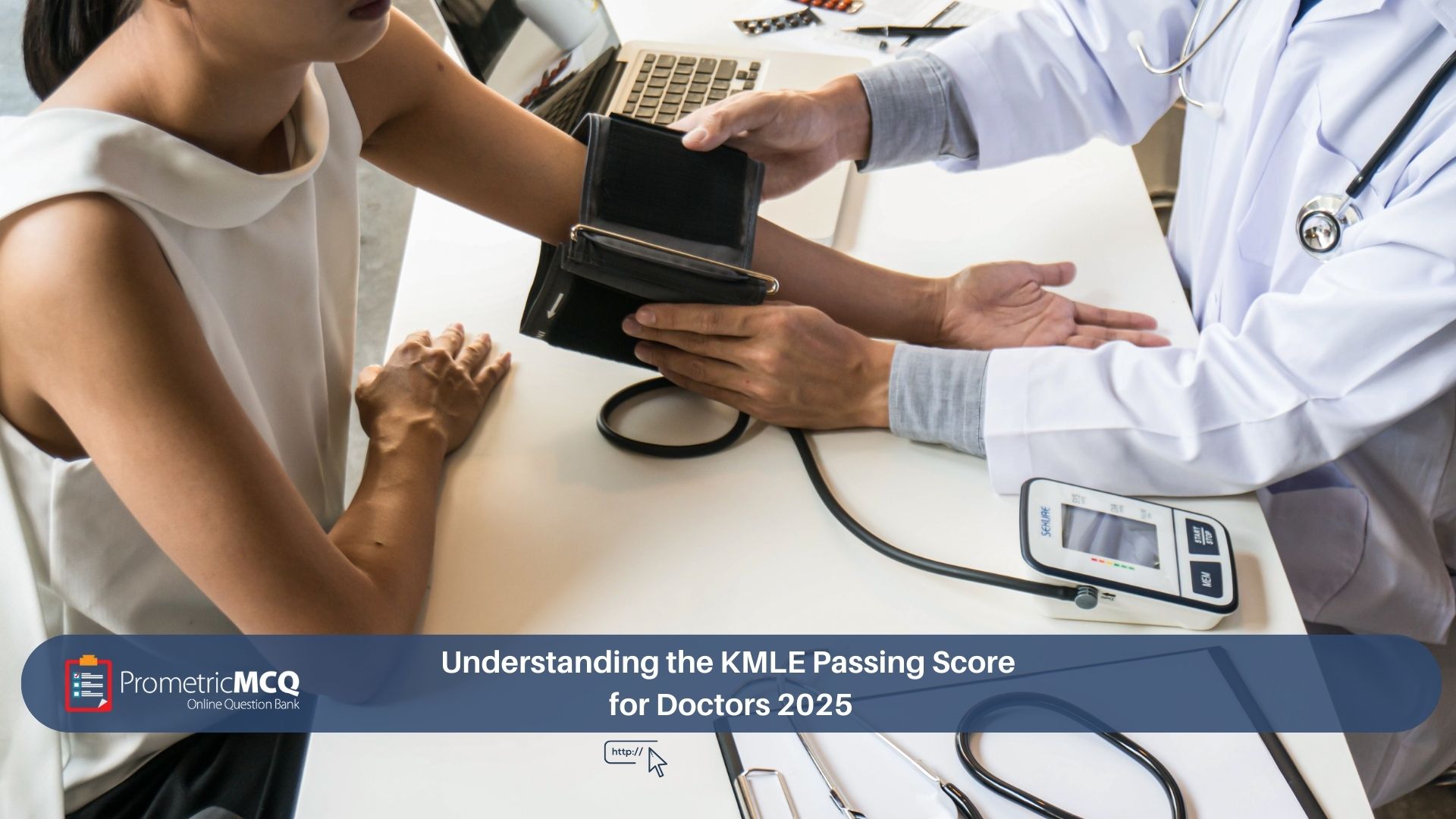
Understanding the KMLE Passing Score for Doctors 2025
fatima@prometricmcq.com2025-09-19T21:32:06+00:00Table of Contents
ToggleUnderstanding the KMLE Passing Score for Doctors (2025)
For medical doctors worldwide, securing a license to practice in Kuwait’s advanced and respected healthcare system is a significant professional milestone. The key that unlocks this opportunity is the Kuwait Medical Licensing Examination (KMLE). As physicians embark on their preparation, a single, pressing question often dominates their thoughts: “What is the exact passing score I need to achieve?” This desire for a concrete target is natural, as the KMLE is a high-stakes assessment that determines one’s eligibility to care for patients in the country.
However, the concept of a “passing score” for the KMLE is more sophisticated than a simple percentage. The exam, administered by Prometric on behalf of the Ministry of Health, is not graded on a curve. Instead, it is a criterion-referenced test, meaning its goal is to determine if a candidate possesses the minimum level of clinical competence required for safe and effective practice. The standard is absolute, not relative to the performance of other candidates. This distinction is crucial for shaping a winning study strategy.
This ultimate 2025 guide will thoroughly demystify the KMLE passing score for doctors, including both General Practitioners and Specialists. We will delve into the psychometric principles behind the scoring, provide the widely accepted passing benchmarks, and, most importantly, outline a strategic framework for scoring well above this threshold. Complemented by a detailed 10-point FAQ, this article aims to replace uncertainty with a clear, actionable plan, empowering you to approach the KMLE with the confidence of a well-prepared physician.
Key Takeaways on the KMLE Passing Score for Doctors
- Official Result is Pass/Fail: The Ministry of Health does not provide a numerical score; your official result will simply be “Pass” or “Fail.”
- No Single “Magic Number”: There is no officially published passing percentage. The standard is determined by a panel of experts for each exam version.
- The Unofficial Benchmark: The estimated passing range for both General Practitioners and Specialists is 60% to 65%.
- The “Buffer Zone” Strategy: The most effective approach is to aim for a consistent score of 70-75% or higher on high-quality practice exams. This creates a safe margin for success.
- All Questions are Equal: With no negative marking, it is critical to attempt every single question on the exam.
Demystifying the Scoring: How the KMLE Pass Mark is Determined
To prepare effectively, you must first understand the philosophy behind the scoring system. It is a robust process designed to ensure fairness and uphold a consistent standard of medical competence. For more details on the exam itself, our KMLE guide for medical professionals offers a broad overview.
1. Criterion-Referenced Testing, Not Norm-Referenced
The KMLE is not graded on a curve (norm-referenced), where a certain percentage of candidates must fail. Instead, it is criterion-referenced. This means a panel of subject matter experts has predetermined the minimum standard of knowledge and clinical reasoning a doctor must demonstrate to be deemed competent. Your performance is measured against this fixed standard. In theory, if every candidate meets this standard, every candidate will pass.
2. Psychometric Analysis and Scaled Scoring
To maintain exam security, multiple versions (or “forms”) of the KMLE are in circulation at any given time. It’s possible that one form may be marginally more or less difficult than another. To account for this, a statistical process called equating is used. This process adjusts for slight variations in difficulty, converting your raw score (the number of questions you got right) into a scaled score. This ensures that the passing standard remains consistent for everyone, regardless of which exam form they were assigned. This is why a simple percentage can be misleading; the underlying standard of competence is what truly matters.
The KMLE does not ask, “Is this candidate better than the others?” It asks, “Does this candidate meet the minimum standard required to safely practice medicine in Kuwait?” Your preparation should be focused on proving that you meet this standard.
KMLE Passing Score: A Breakdown for GPs and Specialists
While the scoring principles are universal, the content and focus of the exams differ between General Practitioners and Specialists. Understanding these differences helps in contextualizing the passing standard.
General Practitioners (GPs)
Estimated Passing Score
The KMLE for GPs is an examination of breadth. It is designed to assess a physician’s ability to manage the wide variety of common conditions seen in a primary care setting. The passing standard reflects this broad scope.
- Why this range? A GP is expected to be the first point of contact for patients of all ages with a vast array of problems. The exam ensures that a passing candidate has a safe and effective knowledge base across Internal Medicine, Pediatrics, OB/GYN, and other core areas. The 60-65% benchmark ensures competence in diagnosing common diseases, managing chronic conditions, and, crucially, recognizing emergencies that require specialist referral.
- Strategic Implication: You cannot afford to have a significant weakness in any major domain. While Internal Medicine is the largest component, a poor performance in Pediatrics or OB/GYN can easily pull your score below the passing threshold. A balanced study approach is key.
Specialists (e.g., Internal Medicine, Pediatrics, General Surgery)
Estimated Passing Score
The KMLE for Specialists is an examination of depth. It assesses advanced knowledge, nuanced clinical judgment, and familiarity with the latest evidence-based guidelines within a specific field.
- Why this range? The passing standard for specialists is set to ensure that a candidate possesses a level of expertise significantly beyond that of a GP. The exam will include more complex cases, questions about second or third-line therapies, and interpretation of more advanced diagnostic tests. The 60-65% benchmark reflects the ability to manage complex patients within that specialty according to international best practices.
- Strategic Implication: While the subject matter is narrower, the required level of detail is much greater. Success depends on a deep dive into your specialty’s core textbooks, landmark clinical trials, and current management guidelines from reputable bodies like the National Institute for Health and Care Excellence (NICE).
The “Buffer Zone”: The Ultimate Strategy to Guarantee a Pass
Given the uncertainty of the exact pass mark and the use of scaled scoring, the most effective strategy is not to aim for the minimum but to create a substantial “buffer zone.”
Aim for 70-75% in Practice Exams
Consistently scoring in the 70-75% range (or higher) on high-quality, timed practice tests is the single most reliable indicator of exam readiness. Here’s why this strategy works:
- It Accounts for Exam-Day Anxiety: Performance on exam day is often slightly lower than in practice due to stress and pressure. A 10-15% buffer ensures that even with a slight drop in performance, you are still comfortably above the passing threshold.
- It Overcomes Difficult Questions: Every exam has exceptionally difficult or poorly worded questions. A strong overall knowledge base allows you to absorb these “lost” points without jeopardizing your result.
- It Builds Confidence: Walking into the exam knowing you have consistently performed well above the target score is a powerful psychological advantage that can reduce anxiety and improve focus.
Achieving this buffer zone requires a dedicated study plan built around high-quality resources, like a specialized KMLE General Practitioner question bank.
Frequently Asked Questions (FAQs) on the KMLE Passing Score
The Ministry of Health does not publish an official passing percentage. The result is provided as a simple Pass or Fail. The widely accepted benchmark of 60-65% is an estimation based on years of candidate experiences and expert analysis of the exam’s difficulty.
Not necessarily, but it is a significant warning sign. A score in the low 60s or below indicates that you are “on the bubble” and at high risk of failing the actual exam, especially after accounting for exam-day stress. You should intensify your preparation, focusing on your weak areas.
No. Similar to the “Pass” result, a “Fail” result does not come with a numerical score or a diagnostic breakdown of your performance. This makes it critical to use the analytics from your practice question bank to identify and remedy your knowledge gaps before your next attempt.
Typically, candidates are allowed a total of three attempts to pass the licensing exam. There is usually a waiting period between attempts. It is imperative to use this time to fundamentally change your study strategy rather than simply repeating the same methods.
In principle, yes. While the content is vastly different, the *standard of competence* required to pass is determined independently for each specialty. The goal is to ensure that a passing candidate in any field is a safe and competent specialist according to international benchmarks for that specific field.
Upon passing the KMLE, you are issued an eligibility letter, which is generally valid for one calendar year. Within this period, you must complete all other licensing requirements, including Primary Source Verification (PSV), and secure a job offer to activate your license.
While an excellent achievement, a very high score confers no official advantage. The outcome is still “Pass.” The practical advantage is the high degree of confidence and reduced stress you will have during the exam process.
Yes. The panel of subject matter experts can periodically review and adjust the passing standard to reflect changes in medical practice, evolving clinical guidelines, or an analysis of overall candidate performance. However, these changes are typically minor and are made to maintain the integrity and relevance of the exam.
No, employers will only see that you have a valid eligibility letter or license from the Ministry of Health. They do not have access to your numerical score. Your success in the job market will depend on your CV, clinical experience, and interview performance.
There is a strong consensus on this: a structured study plan centered on a high-volume, high-quality question bank. Active problem-solving with case-based MCQs is far superior to passive reading. It builds the clinical reasoning, pattern recognition, and time management skills essential for exceeding the passing standard. Exploring comprehensive MCQs packages can provide the necessary resources.
Conclusion: From Understanding to Exceeding the Standard
The pursuit of the KMLE passing score should not be a source of anxiety. Instead, view it as a clearly defined benchmark of clinical excellence. By understanding that the exam is a measure of competence, not competition, you can shift your focus from chasing a “magic number” to achieving true mastery of your subject matter. The most reliable path to success is to prepare with such thoroughness and strategic insight that the passing score becomes an afterthought. Aim for the 70-75% buffer zone in your practice, build your confidence through active problem-solving, and you will be fully prepared to pass the KMLE and begin your distinguished medical career in Kuwait.
Stop Worrying About the Score. Start Building Your Mastery.
Our comprehensive question banks for General Practitioners and Specialists are filled with thousands of high-yield clinical scenarios, detailed rationales, and simulated exams designed to push your performance well beyond the passing threshold.










